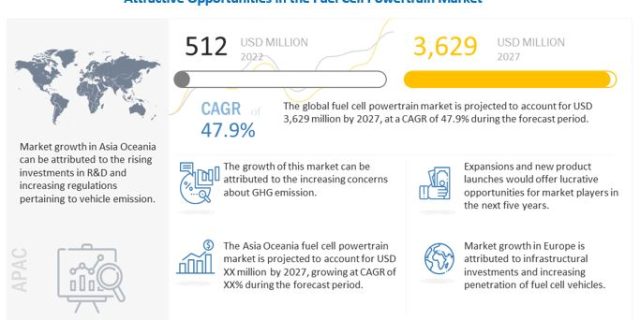
The global fuel cell powertrain market size is projected to grow from USD 512 million in 2022 to USD 3,629 million by 2027, at a CAGR of 47.9%. The fuel cell powertrain market has witnessed rapid year-on-year growth in the Asia Oceania region. The region comprises some of the fastest-developing economies in the world, such as China, Japan, South Korea, and Australia. Even though this region is home to fewer companies in the fuel cell powertrain market compared to other regions such as North America and Europe, the highest number of fuel cell vehicles have been sold here. For instance, in 2021, Among the top sold FCEV models such as Hyundai NEXO and Toyota Mirai between these two models Toyota Mirai was the largest selling FCEV model across the globe.
Japan is aiming at a target of setting up 900 hydrogen refueling stations and 800,000 fuel cell cars by 2030. In South Korea, the Ministry of Knowledge Economy is also undertaking similar efforts to promote fuel cells in the country. Headquartered in Japan, JX Nippon, Toshiba, and Panasonic are the three largest players in the Asia Pacific region. Passenger cars account for the majority of the FCEV market followed by buses, trucks, and LCVs. As of 2021, Japan has world’s highest number of hydrogen power stations followed by Germany, US, France, etc. which will play a major role in driving the market.
Request Sample Report: https://www.marketsandmarkets.com/requestsampleNew.asp?id=158141762
The US is projected to be the largest and the fastest growing fuel cell powertrain market in North America. The country has been at the forefront of the development of fuel cell vehicles and hydrogen infrastructure in the region. In July 2021, the Department of Energy announced USD 52.5 million of funding for 31 projects to advance next-generation clean hydrogen technologies. Besides, the Fiscal Year 2022 Budget proposes USD 197.5 million for supporting efforts to enable adoption of hydrogen and fuel cell technologies. California is a key state in the country that is focusing on and promoting the use of hydrogen vehicles. The state has made significant investments in the development of hydrogen infrastructure for FCEVs. Currently, it has the largest number of fuel cell cars on the road. Canada is projected to be the fastest growing market during the forecast period. The country is home to leading fuel cell suppliers such as Ballard Power Systems and Hydrogenics. So, these are the key factors that will drive the market over the forecast period.
The Netherlands has a high traffic density and short travel distances, which makes fuel cell vehicles suitable for transportation in the country. The country also has the advantage of abundant natural gas resources for hydrogen production. Developments in the field of hydrogen fuel technology are carried out by the Dutch Hydrogen Coalition. This coalition is funded by local authorities in Amsterdam, Rotterdam, and Arnhem, NedStack and HyGear, HyTruck and APTS, Air Products and Linde, Shell, and the Netherlands Energy Research Centre (ECN). Committee initiatives and the wide-scale acceptance of electric vehicles in the country will propel the fuel cell powertrain market in the Netherlands.
Inquire Before Buying: https://www.marketsandmarkets.com/Enquiry_Before_BuyingNew.asp?id=158141762
Key Players:
The global fuel cell powertrain market include major players such as Ballard Power Systems (Canada), Cummins Inc. (US), Denso Corporation (Japan), Robert Bosch GmbH (Germany), and FEV (Germany)
Related Report:
Plastics for Electric Vehicle Market – Global Forecast to 2027
Electric Construction Equipment Market – Global Forecast to 2027
Sensor Market for Automated Vehicles – Global Forecast to 2030

